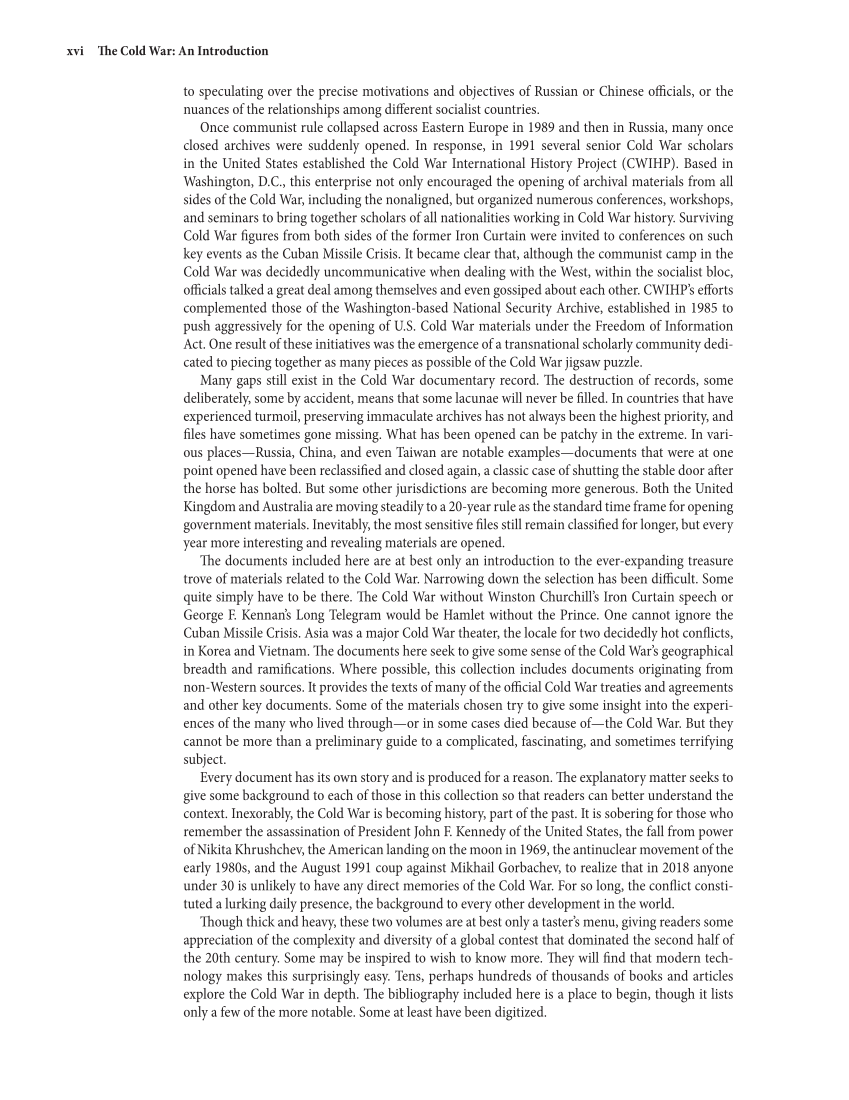xvi The Cold War: An Introduction to speculating over the precise motivations and objectives of Russian or Chinese officials, or the nuances of the relationships among different socialist countries. Once communist rule collapsed across Eastern Europe in 1989 and then in Russia, many once closed archives were suddenly opened. In response, in 1991 several senior Cold War scholars in the United States established the Cold War International History Project (CWIHP). Based in Washington, D.C., this enterprise not only encouraged the opening of archival materials from all sides of the Cold War, including the nonaligned, but organized numerous conferences, workshops, and seminars to bring together scholars of all nationalities working in Cold War history. Surviving Cold War figures from both sides of the former Iron Curtain were invited to conferences on such key events as the Cuban Missile Crisis. It became clear that, although the communist camp in the Cold War was decidedly uncommunicative when dealing with the West, within the socialist bloc, officials talked a great deal among themselves and even gossiped about each other. CWIHP’s efforts complemented those of the Washington-based National Security Archive, established in 1985 to push aggressively for the opening of U.S. Cold War materials under the Freedom of Information Act. One result of these initiatives was the emergence of a transnational scholarly community dedi- cated to piecing together as many pieces as possible of the Cold War jigsaw puzzle. Many gaps still exist in the Cold War documentary record. The destruction of records, some deliberately, some by accident, means that some lacunae will never be filled. In countries that have experienced turmoil, preserving immaculate archives has not always been the highest priority, and files have sometimes gone missing. What has been opened can be patchy in the extreme. In vari- ous places—Russia, China, and even Taiwan are notable examples—documents that were at one point opened have been reclassified and closed again, a classic case of shutting the stable door after the horse has bolted. But some other jurisdictions are becoming more generous. Both the United Kingdom and Australia are moving steadily to a 20-year rule as the standard time frame for opening government materials. Inevitably, the most sensitive files still remain classified for longer, but every year more interesting and revealing materials are opened. The documents included here are at best only an introduction to the ever-expanding treasure trove of materials related to the Cold War. Narrowing down the selection has been difficult. Some quite simply have to be there. The Cold War without Winston Churchill’s Iron Curtain speech or George F. Kennan’s Long Telegram would be Hamlet without the Prince. One cannot ignore the Cuban Missile Crisis. Asia was a major Cold War theater, the locale for two decidedly hot conflicts, in Korea and Vietnam. The documents here seek to give some sense of the Cold War’s geographical breadth and ramifications. Where possible, this collection includes documents originating from non-Western sources. It provides the texts of many of the official Cold War treaties and agreements and other key documents. Some of the materials chosen try to give some insight into the experi- ences of the many who lived through—or in some cases died because of—the Cold War. But they cannot be more than a preliminary guide to a complicated, fascinating, and sometimes terrifying subject. Every document has its own story and is produced for a reason. The explanatory matter seeks to give some background to each of those in this collection so that readers can better understand the context. Inexorably, the Cold War is becoming history, part of the past. It is sobering for those who remember the assassination of President John F. Kennedy of the United States, the fall from power of Nikita Khrushchev, the American landing on the moon in 1969, the antinuclear movement of the early 1980s, and the August 1991 coup against Mikhail Gorbachev, to realize that in 2018 anyone under 30 is unlikely to have any direct memories of the Cold War. For so long, the conflict consti- tuted a lurking daily presence, the background to every other development in the world. Though thick and heavy, these two volumes are at best only a taster’s menu, giving readers some appreciation of the complexity and diversity of a global contest that dominated the second half of the 20th century. Some may be inspired to wish to know more. They will find that modern tech- nology makes this surprisingly easy. Tens, perhaps hundreds of thousands of books and articles explore the Cold War in depth. The bibliography included here is a place to begin, though it lists only a few of the more notable. Some at least have been digitized.
Document Details My Account Print multiple pages
Print
You have printed 0 times in the last 24 hours.
Your print count will reset on at .
You may print 0 more time(s) before then.
You may print a maximum of 0 pages at a time.
































































































































































































































































































































































































































































































































































































































































































































































































































































































































































































































